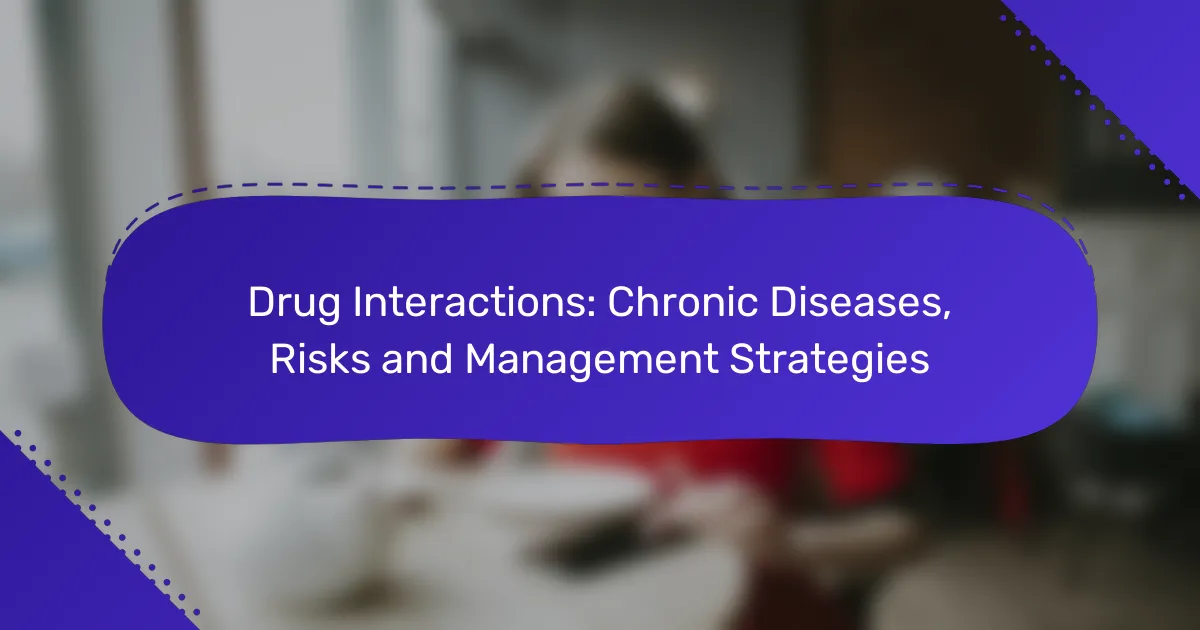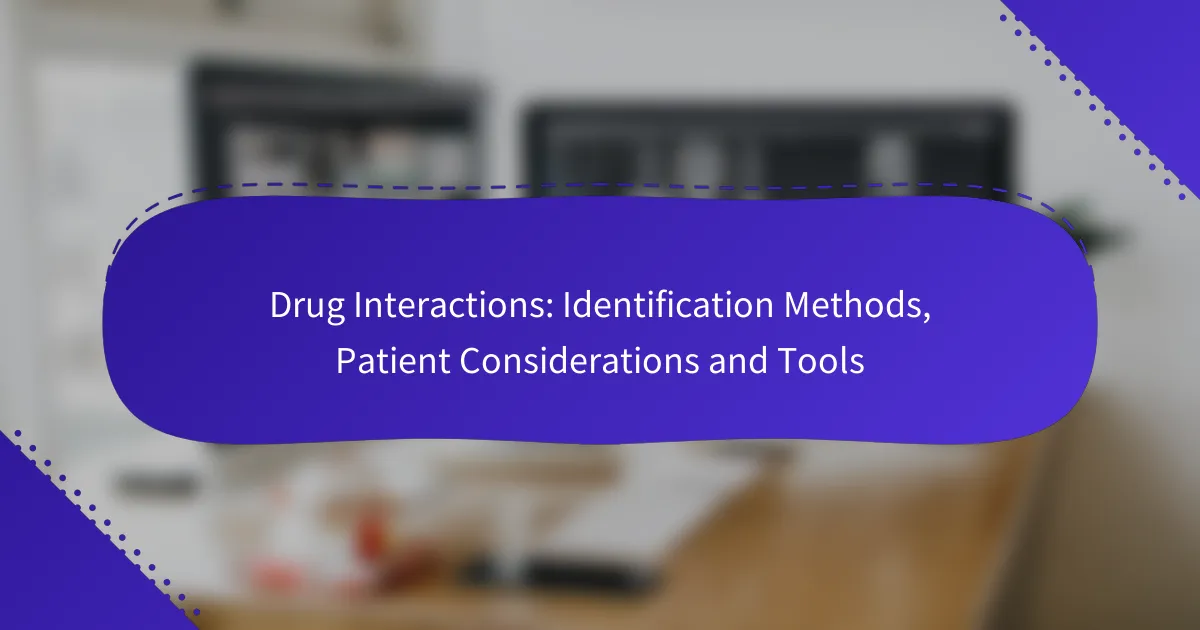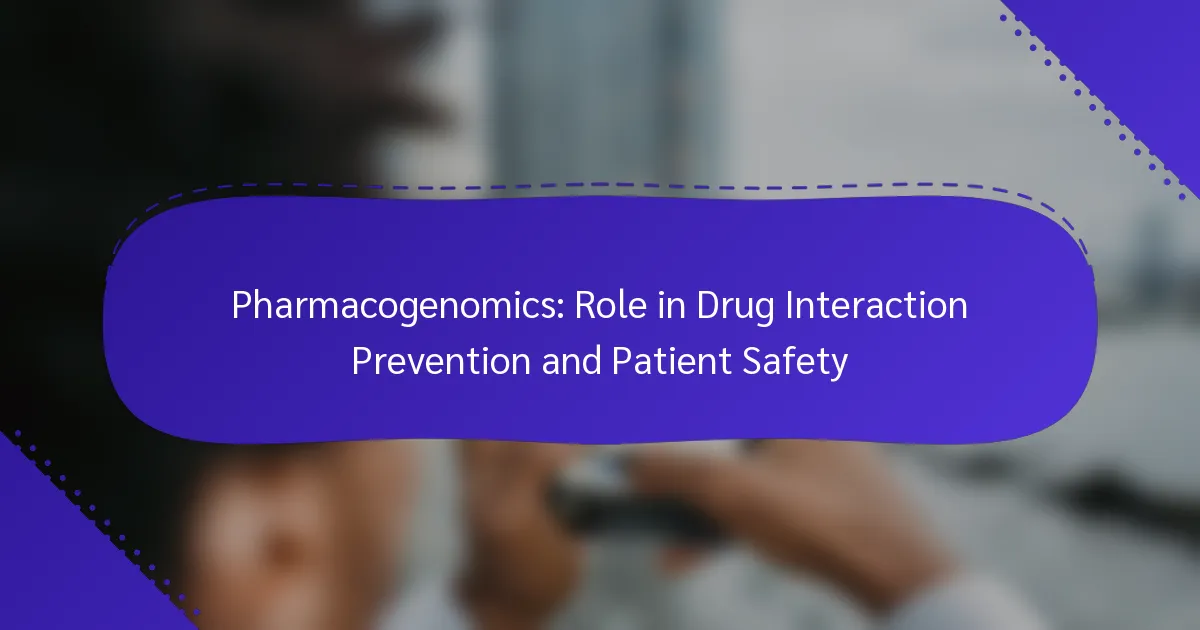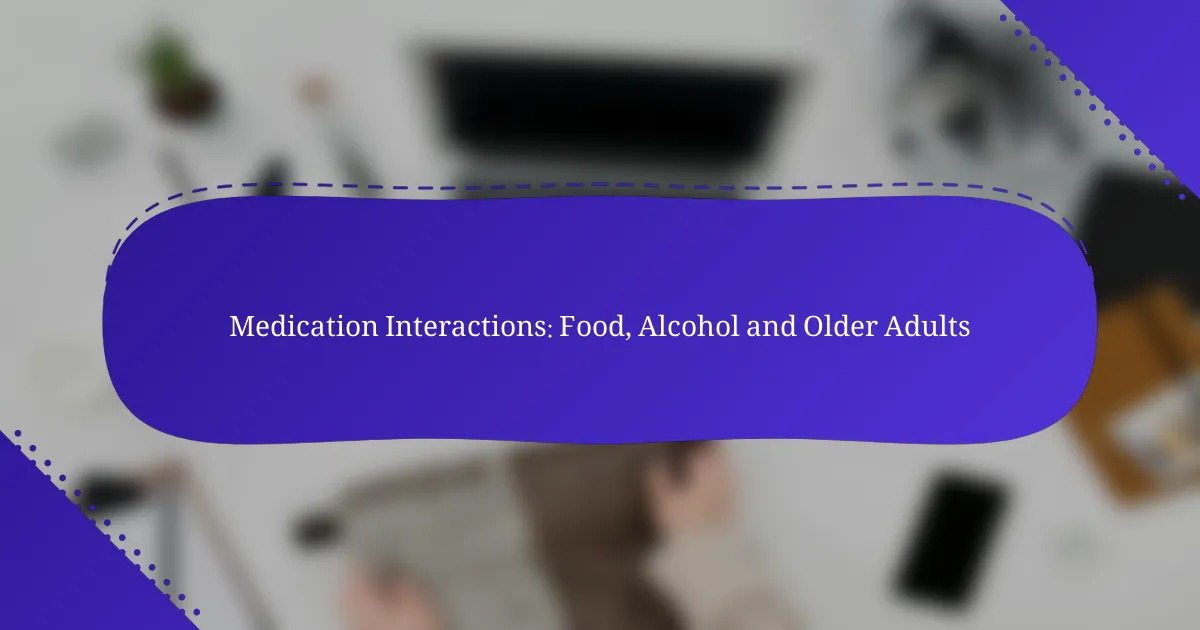Vaistų sąveikos lėtinėse ligose gali reikšmingai paveikti gydymo efektyvumą ir pacientų saugumą. Šios sąveikos dažnai pasireiškia, kai vienos ligos gydymui skirti vaistai veikia kitų ligų gydymo efektyvumą ar saugumą, didindami komplikacijų riziką. Supratimas apie šias sąveikas yra esminis optimizuojant terapinius rezultatus ir užtikrinant pacientų saugumą.
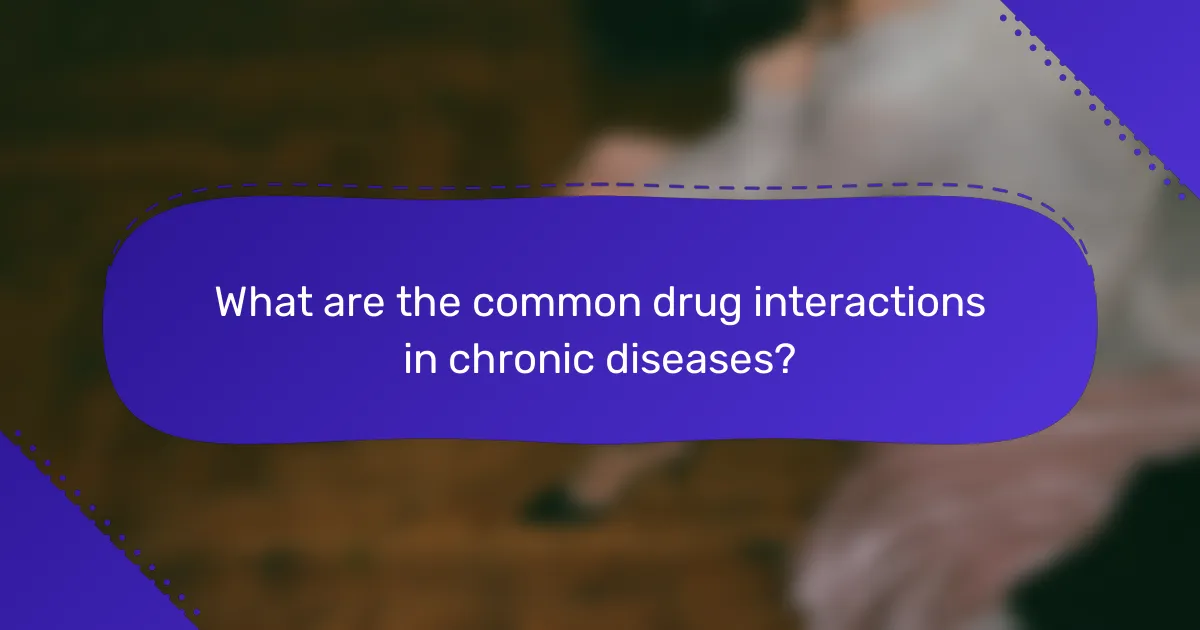
What are the common drug interactions in chronic diseases?
Common drug interactions in chronic diseases can significantly impact treatment effectiveness and patient safety. These interactions often occur when medications prescribed for one condition affect the efficacy or safety of treatments for another condition, leading to increased risks and complications.
Cardiovascular medications and diabetes
Patients with both cardiovascular diseases and diabetes may face interactions between their medications. For instance, certain antihypertensives can affect blood sugar levels, potentially complicating diabetes management. It’s crucial for healthcare providers to monitor blood glucose levels closely when prescribing these medications.
Common cardiovascular drugs like beta-blockers may mask hypoglycemic symptoms, making it harder for patients to recognize low blood sugar. Regular consultations and adjustments in medication may be necessary to maintain optimal control of both conditions.
Antidepressants and chronic pain medications
Antidepressants, particularly selective serotonin reuptake inhibitors (SSRIs), can interact with chronic pain medications, such as opioids. This combination can increase the risk of serotonin syndrome, a potentially life-threatening condition. Patients should be educated on the signs of this syndrome, which include confusion, rapid heart rate, and muscle rigidity.
When prescribing these medications together, healthcare providers should consider starting at lower doses and gradually increasing them while monitoring for adverse effects. Regular follow-ups can help manage any complications that arise from these interactions.
Antihypertensives and asthma treatments
Antihypertensive medications, especially beta-blockers, can exacerbate asthma symptoms. This is particularly concerning for patients who have both hypertension and asthma, as the use of non-selective beta-blockers can lead to bronchoconstriction. Healthcare providers should opt for cardioselective beta-blockers when necessary.
Patients should be advised to communicate any respiratory issues they experience while on these medications. Adjustments to asthma treatment plans may be required to ensure both conditions are managed effectively without compromising respiratory health.

How do drug interactions affect chronic disease management?
Drug interactions can significantly complicate the management of chronic diseases by altering the effectiveness of treatments and increasing the risk of side effects. Understanding these interactions is crucial for optimizing therapeutic outcomes and ensuring patient safety.
Impact on treatment efficacy
Drug interactions can diminish the effectiveness of medications used to manage chronic diseases. For instance, certain medications may inhibit or enhance the metabolism of others, leading to suboptimal drug levels in the body. This can result in inadequate control of disease symptoms or progression.
Healthcare providers should regularly review a patient’s medication regimen, especially when adding new treatments. A thorough understanding of potential interactions can guide adjustments to dosages or the selection of alternative therapies, ensuring that treatment remains effective.
Increased risk of adverse effects
Drug interactions can lead to an increased risk of adverse effects, which can be particularly dangerous for patients with chronic conditions. For example, combining blood thinners with certain pain relievers may heighten the risk of bleeding complications. Monitoring for side effects is essential to mitigate these risks.
Patients should be educated about the signs of adverse reactions and encouraged to report any new symptoms promptly. Additionally, healthcare providers should consider using tools such as drug interaction checkers to identify potential issues before prescribing new medications.

What strategies can be implemented to manage drug interactions?
Effective management of drug interactions involves several strategies that can help minimize risks and ensure patient safety. Key approaches include regular medication reviews, utilizing drug interaction checkers, and enhancing patient education and awareness.
Regular medication reviews
Conducting regular medication reviews is essential for identifying potential drug interactions, especially for patients with chronic diseases. These reviews should involve healthcare professionals assessing all medications a patient is taking, including over-the-counter drugs and supplements.
During a review, practitioners can evaluate the necessity of each medication, check for interactions, and adjust dosages as needed. It is advisable to perform these reviews at least annually or whenever there is a significant change in a patient’s health status.
Using drug interaction checkers
Drug interaction checkers are valuable tools that can help healthcare providers and patients identify potential interactions between medications. These online resources or software applications allow users to input their current medications and receive alerts about possible interactions.
When using a drug interaction checker, it is important to ensure that the tool is up-to-date and based on reliable databases. Patients should discuss the results with their healthcare providers to understand the implications and decide on necessary adjustments.
Patient education and awareness
Educating patients about drug interactions is crucial for empowering them to manage their medications effectively. Patients should be informed about the importance of disclosing all medications they are taking to their healthcare providers.
Providing clear information on recognizing symptoms of drug interactions can also help patients seek timely medical advice. Simple tips, such as keeping an updated list of medications and understanding the purpose of each drug, can enhance patient engagement in their treatment plans.

What are the risks associated with drug interactions in Lithuania?
Drug interactions in Lithuania can lead to serious health risks, particularly for individuals with chronic diseases. These interactions may result in reduced efficacy of medications, increased side effects, or even life-threatening complications.
Prevalence of polypharmacy
Polypharmacy, defined as the concurrent use of multiple medications, is common among Lithuanian patients, especially the elderly and those with chronic conditions. Studies suggest that a significant percentage of older adults may be taking five or more medications simultaneously, increasing the risk of adverse drug interactions.
Healthcare providers in Lithuania are encouraged to regularly review patients’ medication regimens to minimize unnecessary prescriptions. This proactive approach can help reduce the likelihood of harmful interactions and improve overall patient safety.
Specific case studies in Lithuanian patients
Case studies in Lithuania have highlighted the dangers of drug interactions among patients with chronic diseases such as diabetes and hypertension. For instance, a patient taking both insulin and certain blood pressure medications experienced hypoglycemia due to an interaction that intensified the effects of insulin.
Another case involved a patient on anticoagulants who developed complications after starting a new antibiotic, which increased the anticoagulant’s effects. These examples underscore the importance of careful medication management and the need for healthcare professionals to be vigilant about potential interactions.

What criteria should be considered when selecting medications?
When selecting medications, it is crucial to evaluate patient health history and potential drug interactions. These criteria help ensure safe and effective treatment, minimizing risks associated with chronic diseases.
Patient health history
Understanding a patient’s health history is essential for medication selection. This includes previous illnesses, allergies, and any chronic conditions that may affect drug metabolism or efficacy. For instance, patients with liver or kidney issues may require dosage adjustments.
Additionally, consider the patient’s age, weight, and lifestyle factors, as these can influence how they respond to medications. For example, older adults may be more sensitive to certain drugs, necessitating careful monitoring and potential dose modifications.
Potential drug interactions
Identifying potential drug interactions is critical when prescribing medications. Certain combinations can lead to adverse effects or reduced effectiveness. For example, mixing blood thinners with non-steroidal anti-inflammatory drugs (NSAIDs) can increase bleeding risks.
Healthcare providers should utilize resources such as drug interaction databases to assess compatibility. Regularly reviewing a patient’s medication list can help identify any new prescriptions that may interact with existing treatments, ensuring a safer therapeutic approach.

How can healthcare providers improve patient outcomes?
Healthcare providers can enhance patient outcomes by adopting collaborative approaches and leveraging technology. Effective communication and coordination among healthcare teams, along with the use of electronic health records, play crucial roles in managing chronic diseases and mitigating risks associated with drug interactions.
Implementing interdisciplinary care
Interdisciplinary care involves collaboration among various healthcare professionals, such as doctors, nurses, pharmacists, and social workers. This teamwork ensures comprehensive patient assessments, which can identify potential drug interactions and chronic disease complications early on.
For example, a pharmacist can review a patient’s medication regimen to spot interactions that a primary care physician might overlook. Regular interdisciplinary meetings can facilitate knowledge sharing and improve care plans tailored to individual patient needs.
Utilizing electronic health records
Electronic health records (EHRs) streamline patient information sharing among healthcare providers, enhancing the management of chronic diseases. EHRs can flag potential drug interactions and provide alerts when a new medication is prescribed, reducing the risk of adverse effects.
Healthcare providers should ensure that EHR systems are updated regularly and that all team members are trained to use them effectively. This practice not only improves patient safety but also fosters better coordination of care, ultimately leading to improved health outcomes.

What are the emerging trends in drug interaction management?
Emerging trends in drug interaction management focus on personalized medicine and technology integration to enhance patient safety. These approaches aim to minimize adverse effects and improve therapeutic outcomes through tailored treatment plans and advanced monitoring systems.
Advancements in pharmacogenomics
Pharmacogenomics is revolutionizing drug interaction management by analyzing how genes affect individual responses to medications. This field allows healthcare providers to customize drug therapies based on a patient’s genetic makeup, reducing the risk of adverse drug reactions.
For example, patients with specific genetic variants may metabolize certain drugs differently, necessitating dosage adjustments or alternative medications. By utilizing pharmacogenomic testing, clinicians can make more informed decisions, leading to safer and more effective treatment plans.
Integration of AI in medication management
Artificial intelligence (AI) is increasingly being integrated into medication management systems to predict and prevent drug interactions. AI algorithms analyze vast amounts of patient data, including medical history and current medications, to identify potential risks and suggest optimal treatment options.
Healthcare providers can leverage AI tools to enhance decision-making processes, ensuring that patients receive the most appropriate therapies. However, it is essential to remain vigilant about the limitations of AI, such as data quality and algorithm transparency, to avoid over-reliance on technology in clinical settings.






